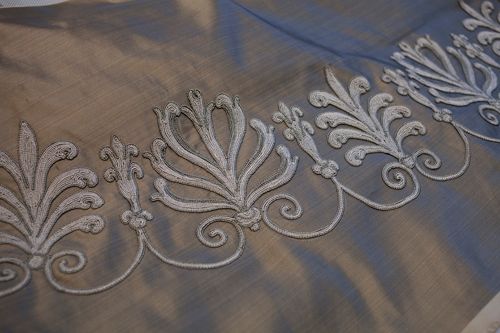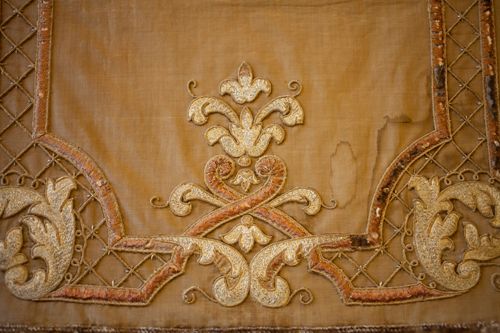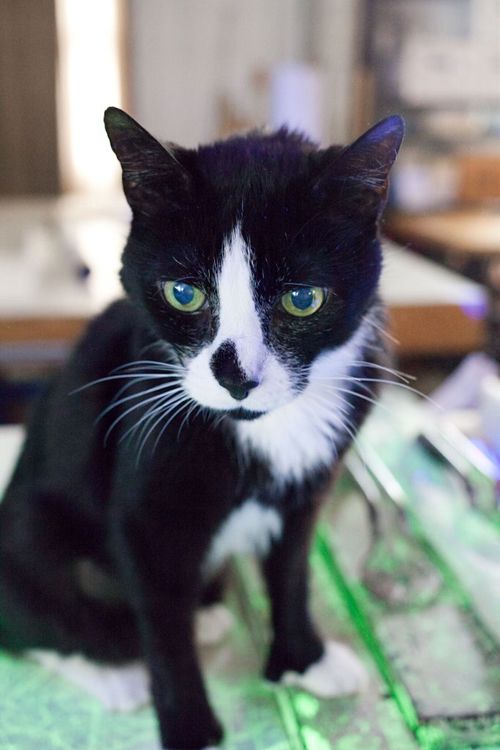
Andrew creates a design on heavy tracing paper.
Readers learned about Penn & Fletcher in Threads #167. Here’s more of the story behind this embroidery house.
On a rainy day in December, contributing editor Kenneth D. King and Senior Technical Editor Judith Neukam paid a visit to Penn & Fletcher with photographer Rob Berezowski. Art Department chief Andrew Marlay demonstrated the various ways of marking fabric for embroidery. Some of the images we didn’t have room to include in the published article are shown below.
 First, Andrew creates a design on heavy tracing paper. He starts with pencil so he can erase if needed. When he’s satisfied with the design, he traces over it with permanent ink.
First, Andrew creates a design on heavy tracing paper. He starts with pencil so he can erase if needed. When he’s satisfied with the design, he traces over it with permanent ink.  Sometimes he loads a mechanical pencil with a sewing machine needle to hand-perforate. This is also done on a padded felt surface, and again, weights hold the paper in place.
Sometimes he loads a mechanical pencil with a sewing machine needle to hand-perforate. This is also done on a padded felt surface, and again, weights hold the paper in place. 
The paper is weighted down on a padded felt surface and the design is perforated, as shown here, with a hand-held mechanical perforator.
Penn & Fletcher satisfies clients’ needs with custom designs, masterpieces from the archives, and from the company’s extensive collection of vintage designs. Many of the designs in this collection are already perforated and ready to transfer or “stamp”, decades after their origin.
 This is a dress front.
This is a dress front.
Punched-sleeve designs
 After the design is perforated, Andrew anchors it to the fabric with heavy weights, keeping the fabric and paper taut.
After the design is perforated, Andrew anchors it to the fabric with heavy weights, keeping the fabric and paper taut.
He uses an ultraviolet (UV) wax product to mark the fabric.
 It must be dissolved from the solid form to a liquid with a cleaning solvent that is compatible with the perforated vellum used for the design.
It must be dissolved from the solid form to a liquid with a cleaning solvent that is compatible with the perforated vellum used for the design.  When he has liquefied the wax, it is spread over the paper, wiped off, the paper pattern is removed and the “stamping” is left to dry.
When he has liquefied the wax, it is spread over the paper, wiped off, the paper pattern is removed and the “stamping” is left to dry.
After the fabric is stamped, it is stabilized on the wrong side with a removable backing such as “burnable buckram”, and is now ready to embroider. On the machine, embroidery artisan Matilda Morillo works under a black light to see the markings while she guides the embroidery machine with one hand from under the table on a two-thread version of a Bonnaz feed machine.
 In this case, the piece is a large, round table cover with an embroidered border.
In this case, the piece is a large, round table cover with an embroidered border.
Here is the finished border.


Penn & Fletcher has enough specialty antique and vintage machines to start a museum.

This is a comparison of the original and the re-created embroidery for a suite of embroidered furniture at Marble House, the Newport summer home of Mrs. Cornelius Vanderbilt II.


 This is a motif from the snake dress worn in Bram Stoker’s Dracula.
This is a motif from the snake dress worn in Bram Stoker’s Dracula.
 An artful example of straight stitching combined with couching.
An artful example of straight stitching combined with couching.  The studio is a large, open space flooded with natural light.
The studio is a large, open space flooded with natural light.  It takes room to house a 12-head embroidery machine.
It takes room to house a 12-head embroidery machine.
The whole company has a family feeling and that might be because there are three permanent feline residents-all siblings-and each has an extra toe on each paw. The cats make themselves at home and are honored on each year’s Christmas card.
 This one watched as Andrew demonstrated.
This one watched as Andrew demonstrated.  Passing along the knowledge.
Passing along the knowledge.
Founder Ernie Smith plans to share his craft by offering a series of classes in different types of embroidery. These classes will be taught on-site in the Penn & Fletcher atelier in Long Island City, New York. For more information on the classes, call Penn & Fletcher at (212)-239-6868.
Do you plan on taking a class at Penn & Fletcher?
photos: Rob Berezowski




















































This company is the Lesage of the United States. They do such extraordinary work! The possibility of learning from them is really exciting, and I'm going to keep looking in on them to see how this is all progressing. Stay tuned!
Wow this is exciting! I used to work for an embroidery company that did all their work by hand in India. I would love to take this class here in NYC!
This article and mini-tour of Penn & Fletcher has been a revelation, such artistry needs preserving for posterity. Many thanks Threads for such an experience. Joan, Australia.
Thank you for this article. I loved seeing the detailed photographs.
I appreciate these articles that illustrate the many fine crafts that go into modern and antique home dec and clothing. It's always a revelation. I hope that such work continues. I wish I could afford something graced with this beautiful embroidery!
wonderful article . wish I lived in the states so I could go . it would be amazing . love the wax technique so much neater than French chalk.
It is nice to get a closer look at how the best work is done.
Wish I could take the class to learn more, but I'm extremely allergic to cats!
Oh well.
I enjoyed this article so very much. I always really appreciate what others are doing and I love the vintage past. This embroidery is just exquisite. I wish I could attend their classes. I appreciate you too, Threads, for such a wonderful magazine and website.
To be able to take a class with this Masters would be a dream come true!
Ode to rainy days in December, curious cats, and learning new skills.
Love the article and the beautiful embroidery. Fantastic. Thank you so much for this article. And, DH and I are cat lovers too! Meow!
This is great work done
BRAVOOOO... Very Well...
keep it up
great article good job
i appreciate this article.
Thanks for sharing this.
Awesome
working hard!!! its nice
its amazing!! very nice
wonderful work
nice
fantastic
nice
Does anyone know the name of the electric device that's holding the mechanical pencil and sewing needle? I've seen similar devices used by professional embroiderers on Youtube videos, where they perforate for the purpose of embroidery transfer, and I've always wondered what it is called or where to buy it.
Thank you